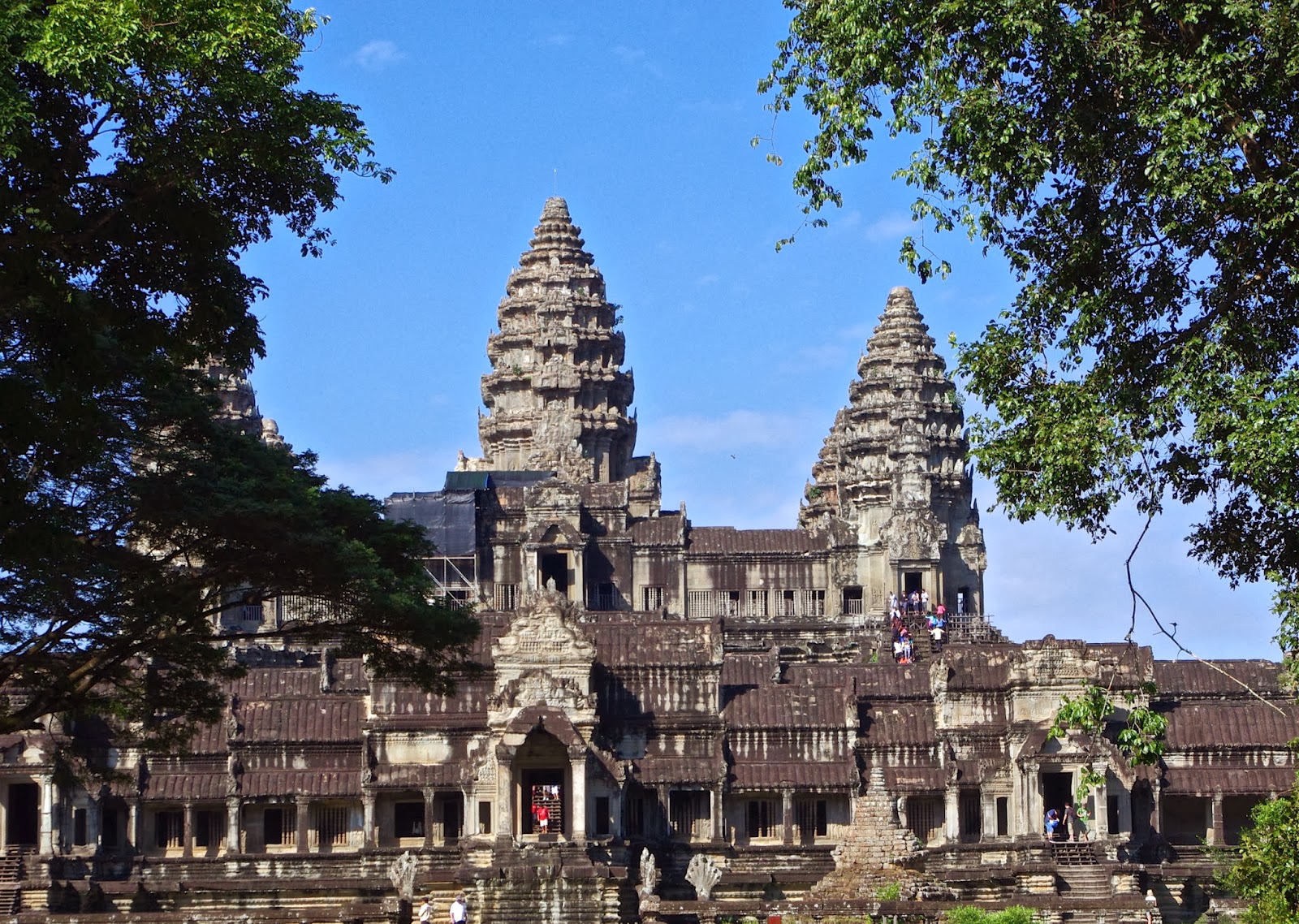 |
| Angkor Wat |
The short flight from Ho Chi Minh City to Siem Reap in Cambodia did not even allow time for a drink but the flights are cheap. The new Cambodian Airline, which works closely with the excellent Vietnamese Airlines, ran a shuttle service from several Vietnamese and Thailand airports to Siem Reap. We arrived at sunset and were surprised at the slightly hostile bank of customs officials, who stamped our visas without a smile as we ran the gauntlet of 15 of them all dressed in severe military uniforms before we were allowed to have our passports inspected. They must have been trained by the Americans who specialise in having the most officious bunch of officials at border control. It was mid-evening by the time we made the hotel so we decided on an early night before the full day of tours the next day.
Angkor Wat lies at the heart of the Angkor Archaeological Park, a UNESCO World Heritage Site which covers 154 square miles and contains scores of other Khmer temples dating from between the 9th and 15th centuries. Angkor Wat is six kilometers north and is the temple closest to Siem Reap. Our guide suggested we visit Angkor Wat early in the morning before visiting the temple of Ta Prohm and then after lunch exploring the massive citadel of Angkor Thom. This was the reverse order of the majority of tours and meant we had the sun behind us as we approached Angkor Wat. A large phalanx of Koreans were coming the other way from lunchtime onwards. The sheer scale of Angkor Wat and the Angkor Thom was beyond our wildest imagination. They are approached through superbly landscaped grounds with serene lakes and beautiful woodlands.
The masterpiece of Angkor Wat is Cambodia’s best-preserved temple. The 500-acre site is one of the largest religious monuments in the world and represents the architectural pinnacle of the Khmer Empire. It was founded in the 12th century and originally dedicated to the Hindu god Vishnu. It has been identified as a replica of the universe, and its towers, moats and concentric walls reveal an architectural sophistication. The walls are covered in bas-reliefs with figures of either apsaras, the dancing girls, or depicting triumphal battle scenes during a wealthy period of history. The figures are carved into sandstone and remain pristine despite the blackening on the female figures where thousands of tourists have stroked the carvings.
Ta Prohm is one of the most photographed temples, deliberately left mostly unrestored, and tangled and strangled by undergrowth. It famously featured in the film Lara Croft: Tomb Raider. This was evidenced by the queues to be photographed in the doorways and beside the tree roots that dominated the decaying temples on this site. We continued through the site to one of the local restaurants for a lunch of noodles, fresh vegetables and fish.
We began the afternoon by entering to the huge citadel of Angkor Thom which once housed almost a million people. The focal point is the Bayon temple, the towers of which are etched with enlightened bodhisattva faces and where bas-reliefs depict ordinary Khmer life rather than Hindu gods. Unfortunately, the afternoon light was flat but the dozens of carved faces provided a jigsaw of immense proportions and it was difficult to leave such a remarkable temple. We exited the Archaeological park by a bridge over the wide moat which was decorated with carved heads. Elephant rides were available but we returned to Siem Reap to enjoy a night out which included cocktails in the colonial club before a ride back to the hotel.
The next day was our final one and after a couple of hours swimming and reading by the pool we enjoyed a few hours in the markets of Siem Reap before flying back to Ho Chi Minh. We had to kill five hours before the flight to Dubai and then Glasgow but the excellent airport restaurant was a wonderful contrast to the franchised food outlets in UK airports. Cambodia had been a great finale for the trip and along with Vietnam a worthy contender for any traveller but just as special were Hanoi, Halong, Hue and Hoi An.
 |
| The moats that surround Angkor Wat |
 |
| Friendly locals |
 |
| Angkor Wat towers |
|
|
The grounds of Angkor Wat
|
 |
| Ta Prohm roots |
 |
| Tomb Raiders |
 |
| Bas relief at the foot of the Bayon temple |
|
|
Buddhist Monks descending from Angkor Thom temple
|
 |
| Carved heads on the bridge over the moat to Angkor Thom |
 |
| A real moat |
 |
| Siem Reap market |






















No comments:
Post a Comment
thanks